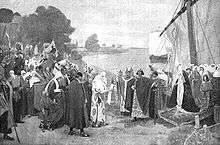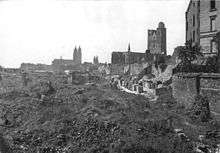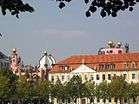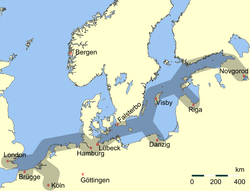Magdeburg
| Magdeburg | ||||||
|---|---|---|---|---|---|---|
From top: Cathedral of Magdeburg, Kloster Unserer Lieben Frauen, Green Citade of Magdeburg and Landtag of Sachsen-Anhalt, Interior of Jahrtausendturm | ||||||
 Magdeburg | ||||||
| Coordinates: 52°8′0″N 11°37′0″E / 52.13333°N 11.61667°ECoordinates: 52°8′0″N 11°37′0″E / 52.13333°N 11.61667°E | ||||||
| Country | Germany | |||||
| State | Saxony-Anhalt | |||||
| District | Urban district | |||||
| Government | ||||||
| • Lord Mayor | Lutz Trümper | |||||
| Area | ||||||
| • Total | 200.95 km2 (77.59 sq mi) | |||||
| Population (2015-12-31)[1] | ||||||
| • Total | 235,723 | |||||
| • Density | 1,200/km2 (3,000/sq mi) | |||||
| Time zone | CET/CEST (UTC+1/+2) | |||||
| Postal codes | 39104–39130 | |||||
| Dialling codes | 0391 | |||||
| Vehicle registration | MD | |||||
| Website | www.magdeburg.de | |||||
Magdeburg (German pronunciation: [ˈmakdəbʊrk]; Low Saxon: Meideborg, [ˈmaˑɪdebɔɐx]) is the capital city and the second largest city of the state of Saxony-Anhalt, Germany. Magdeburg is situated on the Elbe River and was one of the most important medieval cities of Europe.
Emperor Otto I, the first Holy Roman Emperor, founder of the archbishopric of Magdeburg, was buried in the town's cathedral after his death. Magdeburg's version of German town law, known as Magdeburg rights, spread throughout Central and Eastern Europe. The city is also well known for the 1631 Sack of Magdeburg, which hardened Protestant resistance during the Thirty Years' War. Prior to it Magdeburg was one of the largest German cities and a notable member of the Hanseatic League. Magdeburg was destroyed twice in its history.
Magdeburg is the site of two universities, the Otto-von-Guericke University and the Magdeburg-Stendal University of Applied Sciences.[2]
Nowadays Magdeburg is a traffic junction as well as an industrial and trading centre. The production of chemical products, steel, paper and textiles are of particular economic significance, along with mechanical engineering and plant engineering, ecotechnology and life-cycle management, health management and logistics.
In 2005 Magdeburg celebrated its 1200th anniversary. In June 2013 Magdeburg was hit by record breaking flooding.[3]
History

| Largest groups of foreign residents | |
| Nationality | Population (2014) |
|---|---|
| 2,367 | |
| 855 | |
| 708 | |
| 634 | |
| 532 | |
| 456 | |
Early years
Founded by Charlemagne in 805 as Magadoburg (probably from Old High German magado for big, mighty and burga for fortress[4]), the town was fortified in 919 by King Henry I the Fowler against the Magyars and Slavs. In 929 the city went to Edward the Elder's daughter Edith, through her marriage to Henry's son Otto I, as a Morgengabe — a Germanic customary gift received by the new bride from the groom and his family after the wedding night. Edith loved the town and often lived there; at her death she was buried in the crypt of the Benedictine abbey of Saint Maurice, later rebuilt as the cathedral. In 937, Magdeburg was the seat of a royal assembly. Otto I repeatedly visited Magdeburg and was also buried in the cathedral. He granted the abbey the right to income from various tithes and to corvée labour from the surrounding countryside.
The Archbishopric of Magdeburg was founded in 968 at the synod of Ravenna; Adalbert of Magdeburg was consecrated as its first archbishop. The archbishopric under Adalbert included the bishoprics of Havelberg, Brandenburg, Merseburg, Meissen and Naumburg-Zeitz. The archbishops played a prominent role in the German colonisation of the Slavic lands east of the Elbe river.
In 1035 Magdeburg received a patent giving the city the right to hold trade exhibitions and conventions, which form the basis of the later family of city laws known as the Magdeburg rights. These laws were adopted and modified throughout Central and Eastern Europe. Visitors from many countries began to trade with Magdeburg.

In the 13th century, Magdeburg became a member of the Hanseatic League. With more than 20,000 inhabitants Magdeburg was one of the largest cities in the Holy Roman Empire. The town had an active maritime commerce on the west (towards Flanders), with the countries of the North Sea, and maintained traffic and communication with the interior (for example Brunswick). The citizens constantly struggled against the archbishop, becoming nearly independent from him by the end of the 15th century.
In about Easter 1497, the then twelve-year-old Martin Luther attended school in Magdeburg, where he was exposed to the teachings of the Brethren of the Common Life. In 1524, he was called to Magdeburg, where he preached and caused the city's defection from Catholicism. The Protestant Reformation had quickly found adherents in the city, where Luther had been a schoolboy. Emperor Charles V repeatedly outlawed the unruly town, which had joined the Alliance of Torgau and the Schmalkaldic League. Because it had not accepted the Augsburg Interim (1548), the city, by the emperor's commands, was besieged (1550–1551) by Maurice, Elector of Saxony, but it retained its independence. The rule of the archbishop was replaced by that of various administrators belonging to Protestant dynasties. In the following years Magdeburg gained a reputation as a stronghold of Protestantism and became the first major city to publish the writings of Luther. In Magdeburg, Matthias Flacius and his companions wrote their anti-Catholic pamphlets and the Magdeburg Centuries, in which they argued that the Roman Catholic Church had become the kingdom of the Antichrist.
In 1631, during the Thirty Years' War, imperial troops under Johann Tserclaes, Count of Tilly, stormed the city and committed a massacre, killing about 20,000 inhabitants and burning the town in the sack of Magdeburg.[5] The city had withstood a first siege in 1629 by Albrecht von Wallenstein. After the war, a population of only 4000 remained. According to the Peace of Westphalia (1648), Magdeburg was assigned to Brandenburg-Prussia after the death of the current administrator, August of Saxe-Weissenfels, as the semi-autonomous Duchy of Magdeburg; this occurred in 1680.
19th century


In the course of the Napoleonic Wars, the fortress surrendered to French troops in 1806. The city was annexed to the French-controlled Kingdom of Westphalia in the 1807 Treaty of Tilsit. King Jérôme appointed Count Heinrich von Blumenthal as mayor. In 1815, after the Napoleonic Wars, Magdeburg was made the capital of the new Prussian Province of Saxony. In 1912, the old fortress was dismantled, and in 1908, the municipality Rothensee became part of Magdeburg.
20th century

Magdeburg was heavily bombed by the Royal Air Force during the Second World War. The RAF bombing raid on the night of 16 January 1945, destroyed much of the city. The official death toll was approximately 16,000.
Near the end of World War II, the city of about 340,000 became capital of the Province of Magdeburg. Brabag's Magdeburg/Rothensee plant that produced synthetic oil from lignite coal was a target of the Oil Campaign of World War II. The impressive Gründerzeit suburbs north of the city, called the Nordfront, were destroyed as well as the city's main street with its Baroque buildings. It was occupied by United States troops on 19 April 1945 and was left to Red Army on 1 July 1945. Post-war the area was part of the Soviet Zone of Occupation and many of the remaining pre-World War II city buildings were destroyed, with only a few buildings near the cathedral and in the southern part of the old city being restored to their pre-war state. Prior to the reunification of Germany, many surviving Gründerzeit buildings were left uninhabited and, after years of degradation, waiting for demolition. From 1949 on until German reunification on 3 October 1990, Magdeburg belonged to the German Democratic Republic.
Since German reunification
In 1990 Magdeburg became the capital of the new state of Saxony-Anhalt within reunified Germany. Huge parts of the city and its centre were also rebuilt in a modern style. Its economy is one of the fastest-growing in the former East German states.[6]
In 2005 Magdeburg celebrated its 1200th anniversary.
The city was hit by 2013 European floods. Authorities declared a state of emergency and said they expected the Elbe river to rise higher than in 2002. In Magdeburg, with water levels of five metres (16 ft) above normal, about 23,000 residents had to leave their homes on 9 June.[7]
 Magdeburg is the capital and seat of the Landtag of Saxony-Anhalt
Magdeburg is the capital and seat of the Landtag of Saxony-Anhalt- Otto-von-Guericke University Magdeburg was created in 1993
 The Green Citadel of Magdeburg, built in 2005
The Green Citadel of Magdeburg, built in 2005- Magdeburg during the 2013 Elbe flood
 Magdeburg's centre has a number of Stalinist buildings from the 1950s.
Magdeburg's centre has a number of Stalinist buildings from the 1950s.
Climate
Magdeburg has an oceanic climate (Cfb) according to Köppen climate classification.
| Climate data for Magdeburg | |||||||||||||
|---|---|---|---|---|---|---|---|---|---|---|---|---|---|
| Month | Jan | Feb | Mar | Apr | May | Jun | Jul | Aug | Sep | Oct | Nov | Dec | Year |
| Average high °C (°F) | 2.4 (36.3) |
3.8 (38.8) |
8.2 (46.8) |
13.3 (55.9) |
18.8 (65.8) |
21.9 (71.4) |
23.3 (73.9) |
23.3 (73.9) |
19.5 (67.1) |
14.1 (57.4) |
7.5 (45.5) |
3.6 (38.5) |
13.3 (55.9) |
| Daily mean °C (°F) | −0.4 (31.3) |
0.5 (32.9) |
3.9 (39) |
8.0 (46.4) |
13.0 (55.4) |
16.2 (61.2) |
17.5 (63.5) |
17.3 (63.1) |
13.8 (56.8) |
9.5 (49.1) |
4.5 (40.1) |
1.2 (34.2) |
8.75 (47.75) |
| Average low °C (°F) | −3 (27) |
−2.5 (27.5) |
0.4 (32.7) |
3.4 (38.1) |
7.7 (45.9) |
10.9 (51.6) |
12.3 (54.1) |
12.1 (53.8) |
9.4 (48.9) |
5.7 (42.3) |
1.9 (35.4) |
−1.3 (29.7) |
4.75 (40.58) |
| Average rainfall mm (inches) | 33.3 (1.311) |
31.1 (1.224) |
37.9 (1.492) |
40.2 (1.583) |
46.6 (1.835) |
61.5 (2.421) |
48.1 (1.894) |
51.4 (2.024) |
36.1 (1.421) |
29.1 (1.146) |
38.2 (1.504) |
40.6 (1.598) |
494.1 (19.453) |
| Mean monthly sunshine hours | 46.7 | 69.5 | 117.4 | 159.1 | 216.1 | 218.7 | 218.5 | 207.2 | 151.1 | 107.5 | 56.1 | 40.8 | 1,608.7 |
| Source #1: DWD.DE | |||||||||||||
| Source #2: http://www.ecad.eu/download/millennium/millennium.php | |||||||||||||
Main sights
.Linker_Strompfeiler.Dom.ajb.jpg)

Cathedral
One of Magdeburg's most impressive buildings is the Lutheran Cathedral of Saints Catherine and Maurice with a height of 104 m (341.21 ft), making it the tallest church building of eastern Germany. It is notable for its beautiful and unique sculptures, especially the "Twelve Virgins" at the Northern Gate, the depictions of Otto I the Great and his wife Editha as well as the statues of St Maurice and St Catherine. The predecessor of the cathedral was a church built in 937 within an abbey, called St. Maurice. Emperor Otto I the Great was buried here beside his wife in 973. St. Maurice burnt to ashes in 1207. The exact location of that church remained unknown for a long time. The foundations were rediscovered in May 2003, revealing a building 80 m (262.47 ft) long and 41 m (134.51 ft) wide.
The construction of the new church lasted 300 years. The cathedral of Saints Catherine and Maurice was the first Gothic church building in Germany. The building of the steeples was completed as late as 1520.
While the cathedral was virtually the only building to survive the massacres of the Thirty Years' War, it suffered damage in World War II. It was soon rebuilt and completed in 1955.
The square in front of the cathedral (sometimes called the Neuer Markt, or "new marketplace") was occupied by an imperial palace (Kaiserpfalz), which was destroyed in the fire of 1207. The stones from the ruin were used for the building of the cathedral. The presumed remains of the palace were excavated in the 1960s.
Other sights
- Unser Lieben Frauen Monastery (Our Lady), 11th century, containing the church of St. Mary. Today a museum for Modern Art. Home of the National Collection of Small Art Statues of the GDR (Nationale Sammlung Kleinkunstplastiken der DDR).
- The Magdeburger Reiter ("Magdeburg Rider", 1240), the first free-standing equestrian sculpture north of the Alps. It probably depicts the Emperor Otto I.
- Town hall (1698). This building had stood on the market place since the 13th century, but it was destroyed in the Thirty Years' War; the new town hall was built in a Renaissance style influenced by Dutch architecture. It was renovated and re-opened in Oct 2005.
- Landtag; the seat of the government of Saxony-Anhalt with its Baroque façade built in 1724.
- monuments depicting Otto von Guericke (1907), Eike von Repkow and Friedrich Wilhelm von Steuben.
- Ruins of the greatest fortress of the former Kingdom of Prussia.
- Rotehorn-Park.
- Elbauenpark containing the highest wooden structure in Germany.
- St. John Church (Johanniskirche)
- The Gruson-Gewächshäuser, a botanical garden within a greenhouse complex
- The Magdeburg Water Bridge, Europe's longest water bridge
- "Die Grüne Zitadelle" or The Green Citadel of Magdeburg, a large, pink building of a modern architectural style designed by Friedensreich Hundertwasser and completed in 2005.
- Jerusalem Bridge.
Magdeburg is one of the major towns along the Elbe Cycle Route (Elberadweg).
Event venues
- GETEC Arena – Biggest multi-purpose hall in Saxony-Anhalt, home of handball team SC Magdeburg
- AMO - Culture and congress building
- Altes Theater am Jerichower Platz – Former theater, used for parties and large conferences
- Stadthalle - Concert hall
- St. Johannis Church
- St. Petri Church, with stained glass by Charles Crodel
- Seebühne at Elbauenpark
- Messe-Magdeburg
- Paulus Church
- Concert hall Georg Philipp Telemann at "Kloster unser lieben Frauen"
- Projekt 7 – Night club at the university campus. Concerts with indie-pop and rock music
- Factory – Former factory building, German and international pop, rock, metal, and indie music artists are featured
- Kulturwerk Fichte – used mainly for conferences
- Prinzzclub – Night club at Halberstädter Straße – house-, electro and black music
- Festung Mark – Part of the former city fortification, now reconstructed for parties and conventions
- Kunstkantine – Factory cafeteria, monthly electro-music parties
- Feuerwache – Former fire station, repurposed for events
- MDCC-Arena - Home of 1. FC Magdeburg
- Kiste - Student club in Medicine campus
- SC Baracke - Student club on the main University Campus

Education
The Otto-von-Guericke University Magdeburg (German: Otto-von-Guericke-Universität Magdeburg) was founded in 1993 and is one of the youngest universities in Germany. The university in Magdeburg has about 13,000 students in nine faculties. There are 11,700 papers published in international journals from this institute.
The Magdeburg-Stendal University of Applied Sciences was founded in 1991. There are 30 direct study programs in five departments in Magdeburg and two departments in Stendal. The university has more than 130 professors and approximately 4,500 students at Magdeburg and 1,900 at Stendal.
- Aerial view of the University area
- Campustower of the Otto-von-Guericke University Magdeburg
- Magdeburg library
- Magdeburg-Stendal University of Applied Science
Culture and sports

Magdeburg has a proud history of sports teams, with football proving the most popular. 1. FC Magdeburg currently play in the 3. Liga. The now defunct clubs SV Victoria 96 Magdeburg and Cricket Viktoria Magdeburg were among the first football clubs in Germany. 1. FC Magdeburg is the only East German football club to have won a European club football competition. There is also the very successful handball team, SC Magdeburg who are the first German team to win the EHF Champions League.
The city is portrayed as a rebel castle on the strategy map of Medieval II: Total War.
The discus was re-discovered in Magdeburg in the 1870s by Christian Georg Kohlrausch, a gymnastics teacher.
Magdeburg is well known for its Christmas market, which is an attraction for 1.5 million visitors every year. Other events are the Stadtfest, Christopher Street Day, Elbe in Flames and the Europafest Magdeburg
International relations
|
Gallery
- View over Magdeburg in 2012

 Kloster Unser Lieben Frauen
Kloster Unser Lieben Frauen The three churches on the banks of the Elbe river
The three churches on the banks of the Elbe river
- Magdeburg opera
 The Grüne Zitadelle (Green Citadel)
The Grüne Zitadelle (Green Citadel)- Justizzentrum
 View over Elbauenpark with Jahrtausendturm
View over Elbauenpark with Jahrtausendturm Elbe river in Magdeburg
Elbe river in Magdeburg City Hall with Sankt-Johannis-Church
City Hall with Sankt-Johannis-Church Jerusalem Bridges
Jerusalem Bridges The Elbe in Magdeburg
The Elbe in Magdeburg
 The Hasselbachplatz, an important transport hub
The Hasselbachplatz, an important transport hub The Magdeburger Reiter
The Magdeburger Reiter Allee-shopping-centre is one of seven shopping centres
Allee-shopping-centre is one of seven shopping centres
People
A-K
- Max Albert (1905–1976), writer
- Ernst Anders (1845–1911), portrait and genre painter
- Theodor Avé-Lallemant (1806–1890), German music critic and writer on music
- Alfons Bach, (1904–1999), industrial designer[17]
- Kurt Behrens (1884–1928), tower springer
- Arno Bieberstein (1884–1918), swimmer
- Jessica Böhrs, (born 1980), German actress and singer, known for being in the movie Eurotrip
- Adelbert Delbrück (1822–1890), German banker and lawyer
- Friedrich Ernst Fesca (1789–1826), German violinist and composer
- Hans Gericke (1912–2014), architect
- Frank Giering (1971-2010 Berlin), actor
- Harry Giese (1903–1991), German actor and spokesman for Nazi newsreels
- Alfred Grünberg (1901–1942) worker, KPD member and resistance fighter against Nazism

- Otto von Guericke (1602–1686), mayor and inventor of the Magdeburg hemispheres. The Otto-von-Guericke-University of Magdeburg is named after him
- Carl Gustav Friedrich Hasselbach (1809–1882), mayor and member of the Prussian House of Lords, a well known place in the centre of Magdeburg is named after him, the Hasselbachplatz
- Gottlieb von Haeseler (1701–1752), entrepreneur in the Duchy of Magdeburg
- Christian Georg Kohlrausch (1851–1934), gymnastic teacher and re-discoverer of discus throwing
- Carl Hindenburg (1820–1899), cycling official and first president of the German Cyclist Federation (DRB)
- Heinrich Jost (1889–1948), typeface designer
- Georg Kaiser (1878–1945), writer
- Wilhelm Kobelt (1865–1927), member of the Reichstag and local politician in Magdeburg
- Stefan Kretzschmar, (born 1973), retired professional handball player and Olympic medallist
- Hans Kühne (1880–1969), chemist on the board of I.G. Colors and defendant during the Nuremberg trials
L-Z

- Ernst Lehmann (1908–1945), SPD politician, was active in the resistance against Nazism
- Otto Lehmann (1900–1936), German resistance fighter against Nazism
- Werner Marcks (1896–1967), German officer, lieutenant general in World War II
- Olaf Malolepski, (born 1946), singer-songwriter, frontman of German schlager band Die Flippers
- Johann Carl Simon Morgenstern (1770–1852), the philologist who coined the term Bildungsroman
- Werner Naumann (1896–1952), director of the Focke-Wulf aircraft factory in Bremen
- Felix von Niemeyer (1820–1871), physician, royal Württemberg personal physician
- Leo Nowak (born 1929), Roman Catholic bishop of Magdeburg (1990–2004)
- Christiane Nüsslein-Volhard (born 1942), German biologist, won the Albert Lasker Award for Basic Medical Research in 1991 and the Nobel Prize in Physiology or Medicine in 1995
- Richard Ölze (1900–1980), painter
- Erich Ollenhauer (1901–1963), leader of the Social Democratic Party of Germany 1952–1963.
- Menahem Pressler (born 1923), pianist
- Ernst Reuter (1889–1953), mayor of Magdeburg 1931–1933, then mayor of West Berlin from 1948 to 1953.
- Willy Rosen (born 1894 as William Julius Rosenbaum; died October 28, 1944 (according to other sources 30 September 1944) in Auschwitz),
- Ekkehard Schall (1930–2005), actor and theater director
- Karl Schmidt (1902-1945 in the Bay of Lübeck), resistance fighter against Nazism
- Manfred Schoof (born 1936), German jazz trumpeter

- Wolfgang Schreyer (born 1927), writer
- Patrick Schulz (born 1988), handball goalkeeper
- Petra Schmidt-Schaller (born 1980), actress
- Margarete Schön (1895–1985), stage and film actress
- Kurt Singer, (1886–1962), philosopher
- Friedrich Wilhelm von Steuben (1730–1794), an American patriot
- Christoph Christian Sturm (1740–1786), German preacher and author, who wrote the majority of his devotional works here
- Bruno Taut (1880–1938), city architect 1921–1923, completed two housing projects in Magdeburg
- Georg Philipp Telemann (1681–1767), composer
- Klaus Thunemann (born 1937), bassoon professor
- Henning von Tresckow (1901–1944), Major General in the German Wehrmacht, active in the military resistance
- Lothar von Trotha (1848–1920) German military commander notorious for presiding over the near-extermination of the Herero in German South-West Africa.
- Karl Wallenda (1905–1978), highwire acrobat
- Camillo Walzel (1829–1895) librettist and theatre director, who wrote under the pseudonym F Zell
- Dejan Zavec, (born 1976), Slovenian welterweight boxer, IBF Welterweight Champion
- Heinrich Zschokke, (1771–1848), author and reformer
- Arthur Ruppin, (1876–1943), Zionist thinker and leader
- Marcel Schmelzer, (born 1988), German footballer
See also
- The Magdeburg hemispheres, an experimental apparatus used to demonstrate the force of atmospheric pressure in 1656 by scientist Otto von Guericke.
References
- ↑ "Bevölkerung der Gemeinden – Stand: 31.12.2015" (PDF). Statistisches Landesamt Sachsen-Anhalt (in German).
- ↑ https://www.hs-magdeburg.de/home.html
- ↑ 2013 European floods
- ↑ "Magdeburg: Jungfrau oder Groß? Der Ortsname erklärt" (in German). Onomastik.com. Retrieved 2010-07-24.
- ↑ "Religijski rat - "Ubili smo Boga u Magdeburgu!"" (in Serbo-Croatian). Večernji list. 28 January 2016. Retrieved 30 January 2016.
- ↑ http://www.stadtentwicklung-sachsen-anhalt.de/inhalt/situation/
- ↑ Thousands evacuated as Elbe bursts dam in German floods 10 June 2013
- 1 2 3 4 5 6 7 8 Zachert, Uwe; Annica Kunz. "Twin cities". Landeshauptstadt Magdeburg [City of Magdeburg]. Archived from the original on 2012-09-01. Retrieved 2013-08-07.
- ↑ "Braunschweigs Partner und Freundschaftsstädte" [Braunschweig - Partner and Friendship Cities]. Stadt Braunschweig [City of Braunschweig] (in German). Archived from the original on 2012-12-01. Retrieved 2013-08-07.
- ↑ "Sister Cities of Nashville". SCNashville.org. Retrieved August 3, 2011.
- ↑ Міста-побратими м. Запоріжжя [Twin Cities Zaporozhye]. City of Zaporizhia (in Ukrainian). Шановні відвідувачі і користувачі сайту. Archived from the original on 2012-08-03. Retrieved 2013-08-07.
- ↑ "Radom - Miasta partnerskie" [Radom - Partnership cities]. Miasto Radom [City of Radom] (in Polish). Archived from the original on 2013-04-03. Retrieved 2013-08-07.
- ↑ "Radom - miasta partnerskie" (in Polish). radom.naszestrony.pl. Retrieved 2013-08-07.
- ↑ "Harbin Magdeburg twinning". City of Magdeburg. Retrieved 2013-08-08.
- ↑ Florence, Jeanne. "Le Havre - Les villes jumelées" [Le Havre - Twin towns] (in French). Retrieved 2013-08-07.
- ↑ "Le Havre - Les villes jumelées" [Le Havre - Twin towns]. City of Le Havre (in French). Archived from the original on 2013-07-29. Retrieved 2013-08-07. External link in
|work=(help) - ↑ Pace, Eric. "Alfons Bach, 95, Designer of Tubular Furniture". Arts. The New York Times. Retrieved 1 October 2012.
![]() This article incorporates text from a publication now in the public domain: Herbermann, Charles, ed. (1913). "article name needed". Catholic Encyclopedia. New York: Robert Appleton.
This article incorporates text from a publication now in the public domain: Herbermann, Charles, ed. (1913). "article name needed". Catholic Encyclopedia. New York: Robert Appleton.
External links
| Wikimedia Commons has media related to Magdeburg. |
| Wikivoyage has a travel guide for Magdeburg. |
- Official website
- IKUS - the intercultural Students of Magdeburg (English) (German)
- History society of Magdeburg and surround e.V.
- tramway in Magdeburg (English) (German)




